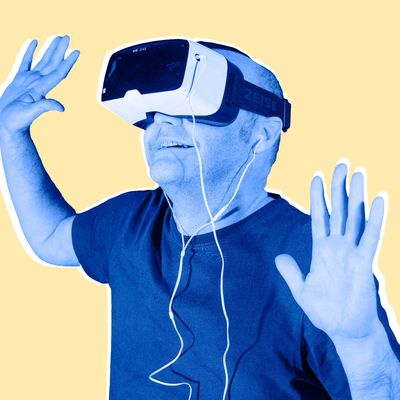
The virtual-reality revolution is coming. Already, Mark Zuckerberg appears to be steering Facebook toward the technology, by purchasing the virtual-reality hardware company Oculus VR for $2 billion. The social-networking site is now increasingly featuring panoramic video, which may set the stage for immersive audiovisual experiences in VR.
Other firms are placing big bets on VR in the workplace, with tech companies like AltSpaceVR developing software intended for use during staff meetings or training sessions; as CEO Eric Romo has said, it’s like “Skype with a presence.” Before you’re invited to attend a VR meeting, know this: Your avatar can influence your behavior in the “real” world in some surprising ways.
You know your thoughts and feelings affect your body language — but this works the other way around, too. Happiness causes us to smile, of course, but smiling also causes us to feel happy. Experimental research suggests that this concept also applies to the virtual space, and that the physical traits of your avatar can change the way you behave in real life. For example, people assigned to obese avatars move less in video games than people assigned to normal weight avatars; people assigned to an avatar who’s running on a treadmill temporarily increase their physical activity. Even when people are comfortably seated, they can feel uncomfortable physiological and cognitive effects from merely adopting the virtual first-person perspective of an avatar that is in an awkward position.
All of this may hint at some practical implications should virtual reality become widely adopted in the workplace, perhaps especially for firms with many remote employees. Stanford researchers Nick Yee and Jeremy Bailenson investigated how the height of a person’s avatar would influence her behavior in a negotiation that took place in a virtual environment, assigning their subjects to a tall, average, or short avatar. In the physical world, tall people are, on average, more likely to acquire social power and status; as it turns out, sadly, even in the virtual realm height bestows an advantage. People who’d been assigned to tall avatars negotiated better deals for themselves than those who’d been assigned to average or short avatars. In fact, subjects assigned to a short avatar were around twice as likely to accept an unfair deal as those in other conditions. Yee and Bailenson named this phenomenon the Proteus Effect, after the shape-shifting Greek god.
Beyond physical characteristics, however, the actions of your avatar appear to influence your behavior, too. In one of my favorite experiments in this field, Bailenson and his colleagues randomly assigned people to one of two virtual experiences in a video game: Half of them were given the ability to fly like a superhero (their arm movements were tracked to control their flight), and the other half rode as a passenger in a helicopter. In addition, half the subjects in each group were randomly assigned to complete a helping task in the video game (getting insulin to a diabetic child), while the other half were assigned a non-helping task (touring the city from above). So there were four conditions: superpowered helper, helicopter helper, superpowered tourist, and helicopter tourist. When the experiment was supposedly finished, the experimenter “accidentally” knocked over a cup filled with 15 pens, spilling them onto the floor. The researchers wanted to know who would be most likely to help pick up the pens.
The type of task in which subjects engaged — helping or non-helping — had no effect on their likelihood of their picking up the pens. But their flying condition did: Compared to the helicopter passengers, people who’d been given superhero flying powers were significantly more likely to help the experimenter pick up the pens and were quicker to pitch in to do it. The superhero flyers also reported slightly higher feelings of “presence” during the game — they felt more “real” and engaged during the virtual task.
Should you be invited someday soon to a VR meeting, I’m not suggesting you attempt to fly into it like a superhero. But if you can project a confident, strong, expansive representation of your authentic self in the virtual world, you might be surprised at the real-life results.
Adapted from Presence: Bringing Your Boldest Self to Your Biggest Challenges by Amy Cuddy; Little, Brown and Company.




